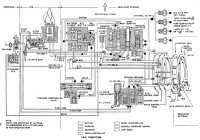The Making of a Flight Engineer
Part 5: Lockheed L-188 Electra
by Floyd J. Stelly
 |
In January 1962 while employed by Eastern Airlines, I started ground school on the Lockheed L-188 Electra. This was my first encounter with turboprops — jet engines using propellers driven through a gear boxes at the front end. The Electra was a very impressive aircraft, but system-wise, the propeller was a lot more complicated than the engine. |
 |
| Propeller Control Schematic |
By the time I checked the out in the aircraft, the serious problems of deadly, unexplained crashes had been solved. Early models had a weak outboard engine mount. In some flight modes this weakness allowed the propeller to get out of its normal plane of rotation. This resulted in a vibration near the natural frequency of the wing, leading to wing structural failure. Modifications to the wing, powerplant and nacelle corrected this problem. The Electra had a number of unique systems and features, some of which will be described below.
The engine operated at only two speeds, 10,000 and 13,820 rpm. The slower speed was for ground operation and the Beta (reverse thrust) range, which meant the throttle controlled the blade angle while the engine maintained the rpm. During flight, the propeller governor maintained the higher rpm and could also be used to phase synchronize the propellers to lower the cabin noise level.
The engine oil cooler doors were manually controlled by the engineer. On the ground while taxing, there was no airflow through the coolers because the prop blade angles were slightly reversed to counter the jet exhaust thrust. This kept the taxi speed down. Associated with each oil cooler was an inducer powered by engine bleed air. The inducer served to create an airflow for oil temperature control.
Each engine was fitted with a 460 KVA 120/208-volt engine-driven generator, which was really an overkill. At the higher speed, each engine produced the correct voltage and frequency. Number four engine had a two-speed generator gear box which would speed up at the lower rpm during taxi and receive the load from the other three generators after their downshift. Before take-off number one, two and three were upshifted to higher rpm and would pick up their respective buses. The number four engine would then upshift.
The hydraulic system was unusual because it had three AC electrical pumps and no engine driven pumps. Two pumps served most systems and the other served as a spare, which could be connected to a failed pump on the ground with a quick-disconnect fitting. A DC battery-operated pump was used by maintenance on the ground while aircraft was being towed for brakes and for operating the airstairs. I’ve never known a brake that had to be replaced because of wear. The propeller did all the braking during landing and taxing.
One of the engineer’s duties was to check fuel quantity. You could always tell the engineer by the kerosene odor that followed him. The four tanks had drip sticks that were lowered and until fuel started dripping. The sticks had fuel quantities graduated in pounds on the outside to verify capacity, since gages were not accurate on ground.
A center point refueling panel was located behind the number three nacelles. Fuel jettison nozzles were located at aft inboard of each wing. The Electra had the best heating and air conditioning system I’ve ever encountered, even better than later model jets. Heating was provided by heat of compression, wall and floor electric heat panels, and air duct electric heaters. Cooling was by dual expansion turbines located on the inboard engine and a Freon system. Radiant heat panels were installed in the passenger cabin side walls and floors and below the cargo compartment floors. An automatic temperature control maintained desired temperature for cockpit and cabin.
Without an APU installed, the aircraft required complete ground support. On gate arrival, an electric power source was plugged in before number four engine was shut down. The starting required an air source for the pneumatic starter.
All in all, I found the aircraft would be relatively trouble-free. I flew the aircraft about one year while employed with Eastern and National Airlines. During that time, I had to feather one engine because of an uncontrollable propeller. This also resulted in fuel being jettisoned to prevent an overweight landing. I don’t recall the Allison 501-D13 engine ever giving us a maintenance problem.
Many of our scheduled flights were less than 30 minutes so we made lots of take-offs and landings. Our cruise altitude for longer flights was about 25,000 feet. This wasn’t the best altitude when you encountered bad weather. We used quite a bit of wing in engine anti-icing and received many lightening strikes.
In April 1966 I started Boeing 727 ground school at National Airlines and by June, I completed my initial checkout. I continued flying the Electra through September. Then the company started to phase them out, making us an all pure-jet airline.
Download Engine Operation Pages from the Electra Flight Manual (993K PDF)
Part 1: C-54s, DC-4s and C-82s in Europe
Part 2. Back Stateside – C-119s from Miami to Greenland
Part 3. Stateside - C-124s
Part 4. Airline Experiences – Lockheed Constellations, Douglas DC-6s and DC-7s
Part 6. Airline experiences – Turbojets
